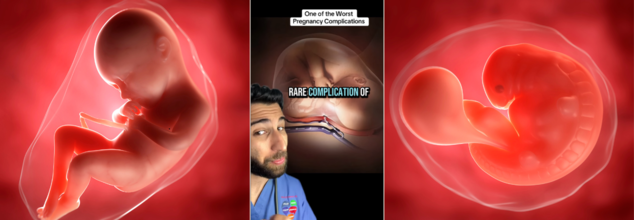- Health Conditions A-Z
- Health & Wellness
- Nutrition
- Fitness
- Health News
- Ayurveda
- Videos
- Medicine A-Z
- Parenting
- Web Stories
Creative Halloween Ideas For Families Skipping Trick-or-Treat This Year

Creative Halloween Ideas For Families Skipping Trick-or-Treat This Year
Halloween time of the year brings excitement with it, but the worry for parents sometimes shines through especially if their little ones are not so keen on trick-or-treating. Whether you're a new town with strange streets or you have a toddler who may find the regular Halloween frights too much, there are a few challenges in planning a Halloween celebration. Don't worry, though; Halloween does not always necessarily involve trick-or-treating. There are many ways to enter the spirit of the season and make lifelong memories with your children.
Here are some fun Halloween ideas for entertaining your kids without trick-or-treating yet still mastering the spirit of the holiday.
Halloween Fun for Toddlers
The trick is to keep things light and fun but without the scary elements for toddlers. Child psychologist Webb says some of the practices that are always brought up as part and parcel of Halloween are too frightening for this age, so it is crucial that activities are determined which highlight the festive side of things without the fear factor.
1. Go to a Carnival
Halloween does not have to be associated solely with October 31st for toddlers. There are many fall carnivals and festivals you can attend that are filled with pumpkin carving, hayrides, and face painting. This should give your child a taste of the Halloween spirit without the scarier side of this holiday. They are usually held throughout the month, making it easier for you.
2. Host a Dinner with Other Families
For instance, think of other families with kids around your little one's age. Possibly the group can organize a Halloween-themed party, be it a costume playdate, a backyard campfire, or something small that way your child will also get a chance to socialize in a setting he or she feels comfortable in.
3. Plan with Daycare or Preschool
Most daycares, preschools, and kindergartens always have Halloween activities during the daytime. In case you are sure that your child will not be trick-or-treating, you can arrange with his school or childcare facility for an eventful Halloween celebration. This way, children can still don their costumes, participate in the events, and enjoy Halloween with their classmates in a familiar environment.
Halloween Ideas for School-Going Children
As they age, your children might become even more fascinated with the cultural traditions surrounding Halloween. But if trick-or-treating is still not possible, that's okay too-there are many other ways to make this day special.
Host a Halloween Party
One of the best ways to have a Happy Halloween with school-age kids is through having a Halloween party. You can invite friends who are also skipping trick-or-treating and a costume parade, organize games, and have Halloween-themed snacks. It's just the right way to let your kids enjoy dressing up and socializing with their friends in a safe and fun environment.
1. Visit a Pumpkin Patch or Corn Maze
Halloween doesn't have to be all about candy. A trip to a pumpkin patch, corn maze, or apple orchard is an entertaining outdoor alternative. Many of these places even host Halloween-themed events, such as evening corn maze experiences or spooky storytelling sessions. And let your kids pick out pumpkins with which to create their own jack-o'-lanterns at home—a nice way to extend the holiday spirit a few days.
2. Host a Halloween Movie Night
If the kids don't feel like trick-or-treating but still want to get in the mood for Halloween, a movie night might be just the ticket. There are a lot of family-friendly Halloween films, including Hocus Pocus, Hotel Transylvania, and Casper. Pop some special Halloween snacks and snuggle up with some cozy blankets in your living room-turned-spooky theater.
3. Halloween Campout
Older kids love the ambiance of sleeping out after dark, and a Halloween campout is the perfect setting for this adventure. Set up a tent in your backyard or at a local campground. Roast marshmallows over a campfire, share scary tales, and let the excitement of dark to dawn seep into the children. Not staying up past bedtime will be part of the fun, too.
4. Host Halloween Fashion Show
If your little ones enjoy dressing up, then hosting a Halloween fashion show is just the ticket! Cull together some old clothes or let them design and make their own DIY outfits. Invite some friends over, and then let those young kids have a chance to showcase themselves before the fashionistas. You could even open it up to include adults in a family Halloween costume contest!
Halloween doesn't need trick-or-treating as its only tradition to be remembered. Whatever be the reason-whether your kids have grown out of hunting for candies or maybe because the tradition won't fit well with your neighborhood-there are hundreds of ways through which you could make the holiday interestingly different for the whole family.
If you have a little creativity, you can plan activities tailored to your children's comfort and a festive atmosphere at home. From movie nights to fashion shows, the possibilities are endless-and what truly matters is spending time together as a family.
So this Halloween, whether it's visiting a pumpkin patch or having a campfire, you can be sure that your kids will enjoy it just as much, if not more, than they would trick-or-treating. All it takes is a bit of imagination and a willingness to embrace the spooky, fun-filled spirit of the season!
'I Am A Nutritionist- These Are 4 Diet Non-Negotiables For My Son's Health'

Credits: Canva
When it comes to raising children, few tasks and responsibilities seem more daunting and less achievable than getting them well-fed and well-nourished. From limiting picky eating to avoiding the allure of ultra-processed snacks, parents today have a daily conundrum: how to feed their children in a manner that sustains growth, builds immunity, and prepares them for health throughout life. But the reality is nutrition for kids is not all about keeping them away from junk. It's about intentionally assembling a diet that nourishes the brain, gut, physical energy, and emotional well-being. And in our uber-speedy world of screen time and sit-tie times, that is more important than ever.
Especially important for the early years when a child's brain is growing like mad, bones are accumulating density, and immune systems are forming. Childhood nutrition does more than fuel playground dashes or after-school games. It sets the foundation for how our children's minds and bodies will operate for decades to come. Proper intake of essential nutrients during early years lowers the risk of chronic disease later in life, such as obesity, diabetes, and cardiovascular diseases, according to the American Academy of Pediatrics.
One of the voices adding sense to this topic is Sakshi Lalwani—a clinical nutritionist with more than 231,000 followers on Instagram. She's also a committed mom, and this dual identity provides her with the practical expertise born of both science and life experience. In one of her much-admired Mother's Day posts, she set out her four non-negotiable rules for feeding her son. Underpinned by science, tradition, and life, these rules are more than a list—they're a code. Here's what she is committed to and why it's deserving of adoption worldwide.
1. Good Fats Are Non-Negotiable—They Feed the Brain
As adults, most of us have spent decades overcoming the fear of fats. But for kids, healthy fats aren't just safe—kids need them. In fact, kids need more fat proportionately than adults because growing brains consist of almost 60% fat. The Harvard School of Public Health says that proper fat consumption in children is directly linked to optimal brain development, hormone function, and energy metabolism.
Lalwani makes good fats a top priority in her son's daily meals. "He has ghee, nut butters, and avocados on his daily plate," she reports. These are whole, intact sources of saturated and monounsaturated fats that not only provide nutrients but also facilitate the absorption of fat-soluble vitamins A, D, E, and K. Ghee, specifically—a common Indian kitchen staple—is high in butyrate, which aids the gut and inflammation regulation. Nut butters provide a tasty delivery system for protein and healthy fat, and avocados deliver fiber, folate, and potassium, a triad of benefits for developing bodies.
2. Iron & Zinc: Micronutrients With Macro Impact
Two minerals that tend to fly under the radar—but are central to children's health—are iron and zinc. Iron is necessary for transporting oxygen in the blood, and even mild deficiencies can cause fatigue, poor concentration, and slowed development. Zinc, meanwhile, is essential for immune function, cell growth, and even taste.
Even slight deficiencies impact concentration, immunity, and growth," Lalwani says, noting that she always adds soaked raisins, lentils, and pumpkin seeds to her son's diet. These foods provide plant-based forms of iron and zinc, which, when combined with vitamin C-rich fruit such as oranges or tomatoes, are easier for the body to absorb. Lentils are also a great source of protein and fiber, so they're a potent dietary ally when it comes to children's growth and digestive health.
Adding these minerals to your diet each day is easy enough: sprinkle pumpkin seeds on top of yogurt, add lentils to a soup, or provide soaked raisins as a snack following school. The important thing, experts say, is simplicity over consistency.
3. Gut Health Is the Silent Architect of Wellness
The saying "all health begins in the gut" is more than a wellness buzzphrase. Emerging research in pediatric nutrition shows that a healthy gut microbiome is linked to improved mood regulation, cognitive function, immune defense, and nutrient absorption. It’s no surprise, then, that gut health is one of Lalwani’s cornerstones.
“A healthy gut supports better mood, focus, and digestion,” she notes. To those ends, she incorporates foods such as curd (yogurt), bananas, garlic, and oats into her family's diet on a regular basis. Yogurt gives us probiotics, the good bacteria that ensure a balance of gut flora. Bananas are full of prebiotics—food for the good bacteria—while garlic contains antimicrobial activity and immune benefits. Oats not only have fiber to control digestion but also encourage the development of good bacteria in the colon.
Promoting a rich microbiome from birth has health benefits throughout life, such as lower allergy, eczema, and autoimmune disease risk. For parents, it can start easily—with a probiotic yogurt breakfast or banana-oat smoothie.
4. Early Habits Build Lifelong Wellness
The final pillar in Lalwani’s approach is perhaps the most holistic: building habits now that set the stage for the future. “What he eats now shapes his future metabolism, immunity, and eating habits,” she shares. Nutrition during the early years doesn't just fill tummies—it wires preferences, cravings, and emotional relationships with food.
She also stresses daily sun exposure and soaked almonds, both of which enhance the uptake of vital vitamins and minerals such as Vitamin D and magnesium. Sunlight still stands as the best and the most natural way of obtaining Vitamin D, essential to bone function and immunity. Almonds, when soaked, are easier to assimilate and are a very effective source of magnesium, a mineral that plays a role in more than 300 enzymatic processes in the body.
Establishing these routines early—eating whole foods, enjoying family meals, and spending time outdoors—can create positive associations around health that carry into adulthood.
Sakshi Lalwani’s food philosophy for her son is a timely reminder that children’s diets deserve as much attention and intention as any other aspect of parenting. Her four non-negotiables are more than just nutrition rules—they are a blueprint for nurturing resilient, well-rounded, and thriving individuals.
Pediatrician’s Guide To The First 1000 Days Of Motherhood For All Expecting Mom- Key Tips

Motherhood is as much a transformation as it is a tenderness. Yet whereas most parents anticipate sleepless nights and diaper changes, fewer appreciate how the first 1000 days, from conception to a child's second birthday, shape a baby's health and well-being for the rest of their life.
According to Dr. Kushal Agrawal, HOD, Department of Neonatology and Paediatrics, “The first 1000 days represent a critical window where the brain develops faster than at any other time. Over 80% of brain development occurs by the time the child turns two. What happens during this phase quite literally shapes a child’s cognitive potential, immunity, and emotional well-being.”
This in-depth guide is based on scientific knowledge and pediatric experience to assist mothers, carers, and families in maximizing these critical 1000 days.
Why the First 1000 Days Matter Most?
The initial 1000 days—from conception up to a child's second birthday—are marked by dramatic physical, mental, and emotional development. In these years, brain cells create trillions of connections. Nutrition, love, and physical care at this time determine a child's ability to learn, their immune system, and even their resistance to chronic diseases much later in life.
As Dr. Agrawal puts it, "It's not just about having a healthy baby. It's about laying down the template for future health, behavior, and learning capacity. Every contact, every vitamin, and every cuddle matters."
Before Pregnancy
The process starts even before getting pregnant. Pregnancy planning is not merely a way of life—it's a medical necessity.
"Women intending to conceive should start with a complete medical check-up to tackle underlying health conditions," Dr. Agrawal suggests. "Start folic acid supplements at least three months before. It helps decrease neural tube defects and aids in early fetal growth."
Follow a balanced diet with plenty of iron, calcium, and folate. Avoid alcohol, tobacco, and all recreational drugs several months prior to conception. Being at a healthy pre-pregnancy weight and having properly controlled chronic illnesses such as diabetes or thyroid disease can avoid complications for both mother and child.
During Pregnancy
Being pregnant is a period of increased responsibility. Your baby is completely reliant on you for nutrition and emotional support.
Monthly antenatal visits are essential to monitor fetal growth and detect complications early. Hydration is equally necessary—10–12 glasses of pure water daily. Freshly prepared, nutrient-dense foods in small, frequent servings.
Light exercise like walking or prenatal yoga improves circulation and mood, while good rest—at least 8 hours of unbroken sleep—facilitates fetal growth.
Don't underestimate the power of emotional well-being," Dr. Agrawal says. "High levels of maternal stress can impact the baby's temperament and risk of developmental delays. Participate in stress-lowering activities such as reading, music, or guided meditation."
Post-Birth
The initial hour after birth—often referred to as the "Golden Hour"—is critical. Get breastfeeding started within this timeframe to transfer antibodies and build a robust immune foundation.
Breastfeed exclusively for the first six months—no formula, no water. "Breastmilk is a complete meal. It provides antibodies, essential fats, and immune-boosting enzymes," says Dr. Agrawal.
Daily skin-to-skin contact, talking, smiling, and singing to the baby promote bonding and stimulate early brain development. Vaccines should be given on time, and frequent pediatric checkups are not negotiable.
6 Months to 2 Years
At six months, introduce soft foods made at home in addition to continued breastfeeding. Gradually add a range of fruits, vegetables, cereals, and pulses. Processed foods, salt, sugar, and honey are to be avoided, as they can injure developing organs.
Be sure to keep feeding hygienic. "Encourage self-feeding, let your baby play with textures, and promote movement—crawling, walking, climbing stairs holding someone who can support them. All of these aid in physical and mental development," says Dr. Agrawal.
Restrict screen time. Instead, promote face-to-face interaction with storytelling, playtime, and exploration.
Why Role of the Family Is More Than Shared Responsibility?
Motherhood is not an isolated experience. Fathers, grandparents, and extended family members all help shape the baby's early life.
A supportive family can decrease maternal stress and improve mental health. Share tasks—from diaper changes to soothing at night—and make sure the mother is getting plenty of rest and healthy meals.
"A smoke-free, peaceful home environment enhances not just physical health but also emotional security for mother and baby," Dr. Agrawal stresses.
The first 1000 days are not merely about checking boxes off a list—they are about thoughtful care, emotional connection, and conscious parenting.
What you do today—what you feed, how you sleep, how you communicate with your baby can have a profound impact on your child's cognitive skills, emotional maturity, and physical well-being. As Dr. Agrawal says, "These aren't just days. They are opportunities. Let's make each one count."
Dr Kushal Agrawal is HOD of Department of Neonatology and Paediatrics at KVR Hospital, Kashipur in India
Real Life Story: Doctor Explains 'Worst Pregnancy Complication' That Led To A 33-Year-Old Woman’s Tragic Death

Credits: Canva and Instagram
Among the many rare conditions which are life-threatening, Dr Sermed Mezher, a doctor based in London, a medicine physician and a content creator shared a video explaining 'one of the worst pregnancy complications'.
He says, "There's been a very public case of a 33-year-old woman, who sadly passed away from an exceptionally rare complication of pregnancy recently."
What Are The Facts?
It is called an amniotic fluid embolism, or AFE, which is a rare, but extremely dangerous childbirth complication, he explains. It happens when amniotic fluid, fetal cells, or other debris enter the mother's bloodstream, triggering a severe and sudden immune response. This can lead to rapid cardiovascular collapse, respiratory failure, and life-threatening bleeding due to disseminated intravascular coagulation (DIC), he explains.
He says that it is most difficult to manage this complications during delivery, "as it is when part of the actual amniotic fluid that surrounds the baby or some fetal cells actually get into the maternal bloodstream and spreads to the rest of the body." It causes the whole systems inflammatory allergic reaction.
Why Is It So Difficult To Manage?
He shares that it is because, at this stage multiple systems can start failing at the same time. It leads to cardio respiratory collapse, oxygen levels start plummeting, blood pressure starts falling, and also causes excessive bleeding of something called DIC.
DIC is where clotting factors are all being used up in the blood, and the patient can have seizures at the same time.
He, however does mention that it is an incredibly rare complication, which affects only 1 in 40 to 50,000 pregnancies, between 11 and 43% of mothers not making it through the complication.
What Is AFE?
As per the National Library of Medicine, it is a rare but serious condition with high mortality and morbidity rates and is the second leading cause of peripartum maternal death. It occurs when amniotic fluid enters the maternal bloodstream.
Cardiovascular collapse is often the first sign of amniotic fluid embolism (AFE). It is typically followed by activation of the clotting and fibrinolytic systems, which may lead to disseminated intravascular coagulation. Since no specific test exists, AFE is diagnosed based on clinical assessment.
What May Increase Your Chance of AFE?
- Advanced maternal age (being older than 35 during pregnancy)
- Expecting multiples (twins, triplets or more)
- Fetal distress (changes to the fetal heart rate)
- Issues with the placenta like placental abruption
- Preeclampsia or eclampsia
- Polyhydramnios (too much amniotic fluid)
- Cervical tears
- Labor induction medications or procedures
- Having a C-section delivery
- Operative assisted deliveries (forceps delivery or vacuum extraction)
Are There Any Symptoms?
Signs and symptoms of AFE develop suddenly and quickly, and often they are similar to that of other ordinary complication of pregnancy, which makes it difficult to detect the condition.
However, these could be the following symptoms:
- Shortness of breath or difficulty breathing
- Sudden drop in blood pressure
- Pulmonary edema (fluid in your lungs)
- Abnormal heart rate
- Bleeding from your uterus, C-section incision or IV (intravenous) sites
- Fetal distress
- Agitation, confusion or sudden anxiety
- Chills
© 2024 Bennett, Coleman & Company Limited

